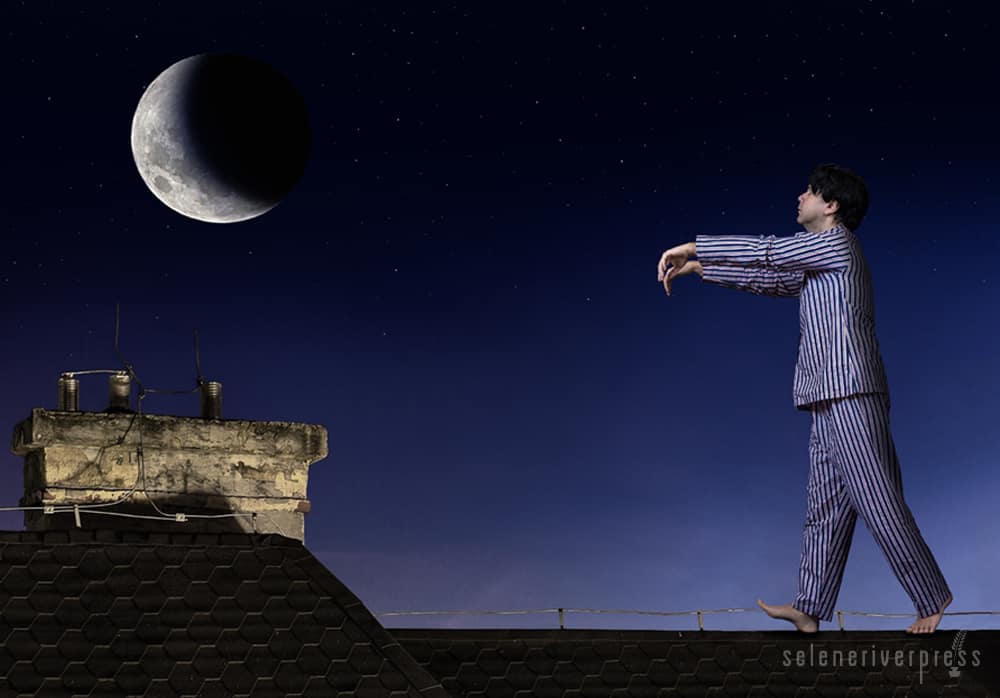We have a sleepwalker in our house, folks. The first time it happened was unnerving, to put it mildly. Our sweet little eight-year-old boy wandered into the living room, blankly stared at my hubby and I, and began relieving himself onto the wood floors with a maniacal laugh. What the what?!
After getting him changed and back to bed, it took a little while to fall asleep ourselves. We had a hard time getting the sound of his laugh out of our heads. But the next morning, it was clear he was completely unaware of what happened. Once we realized we didn’t need to schedule an exorcism, we were able to giggle about the experience, and it still comes up every once in awhile.
After another restless sleep not too long ago, I was more than a little curious about the whole phenomenon. Three times throughout the night, our son came and asked me to lay on his floor, but he didn’t remember it the next morning. What’s the deal with sleepwalking? What makes our youngest the only one in the family susceptible to somnambulism? Is he destined to be a nighttime wanderer forever?
According to MedicineNet.com, about 15 percent of kids sleepwalk. It’s most common between the ages of four to twelve and usually stops by late adolescence. Phew! We may be almost done with it. ;) However, there’s another group of kids who don’t start sleepwalking until the late teen years.
One detail I found super interesting is that sleepwalking episodes tend to happen during stage three of sleep. This stage is “known for surges of important hormones essential for proper growth and metabolism.” While our hormones play an important role in our lives, they can certainly mess with us too.
So what causes a person to head out of their bed for no particular reason? The KidsHealth.org page on sleepwalking offers several interesting answers:
- A random sleep schedule
- Sleep deprivation or fatigue
- Illness and/or fevers
- Certain medications
- Stress (yes, your kids experience stress too)
Hmmm, I’ll have to make a mental note of what may be preceding our boy’s nighttime adventures. But this list does confirm the necessity of a regular bedtime schedule, which is something we always try to make happen in our house. As often as we can, our evening routine starts at around the same time each night: taking a shower or bath, brushing our teeth, reading a book or magazine for a while. All of these habits help lead us into a restful, rejuvenating sleep.
If dozing off and staying asleep is a struggle for you, read Dr. Lowell Keppel’s “It’s Never Too Late to Sleep Like a Baby.” Keppel explains that a sleep-deprived body is giving you clues about what it needs, so pay attention to the signals. Do you fall asleep with minimal effort but wake up around the same time each night? Or does your brain stay busy and wakeful even when your body is worn out? You’ll also find a free infographic that you can print up and keep handy. Hopefully, you’ll be sleeping through the night in no time.
Fortunately, sleepwalkers are usually pretty subdued in their wanderings. They may sit up in bed, talk gibberish, or change out of their pajamas. Rarely does it lead to anything dangerous. However, as the National Sleep Foundation reports, some sleepwalkers head outdoors (think winter with nothing but your pajamas). And sleepwalkers sometimes even get in cars and drive. Yikes!
It’s a myth that you should never awaken a sleepwalker. Sure, it may lead to some grogginess and disorientation, but that’s much better than wandering outside in the dark—especially if they’re heading into drifts of snow without any boots or a warm coat. If you or someone you love engages in more dangerous sleepwalking activities, it’s probably a good idea to mention it to your health care provider. There may be underlying issues to be concerned about or something that can be done to make sure everyone stays safe.
Luckily, our youngest boy’s first sleepwalking experience was a “one and done” situation. It’s nice to know that he’s not a total anomaly and will more than likely grow out of it.
Do you have any experience with sleepwalking?
Image from iStock/riskms.



